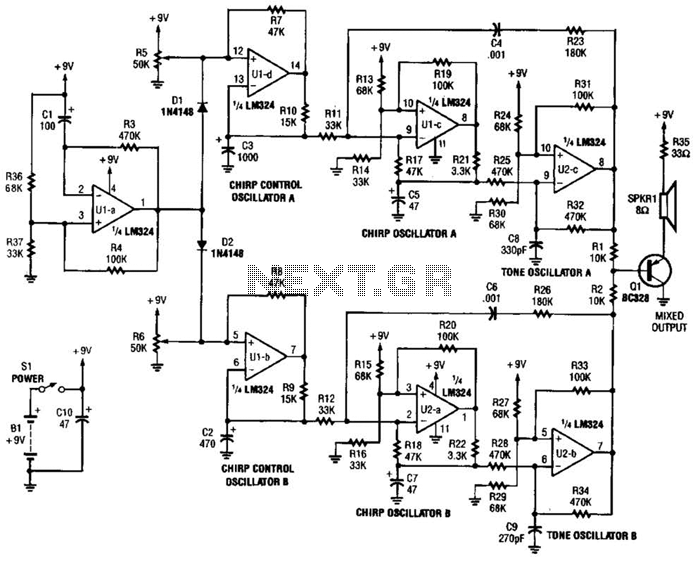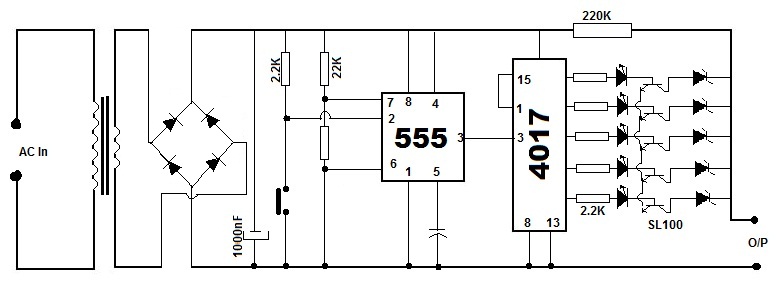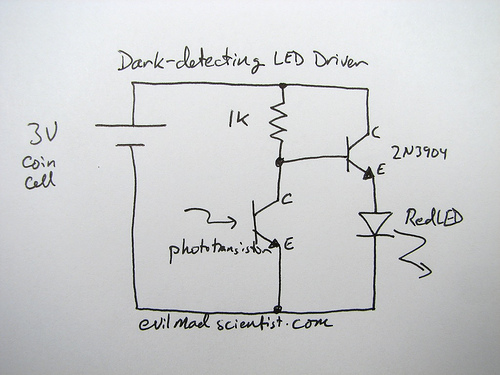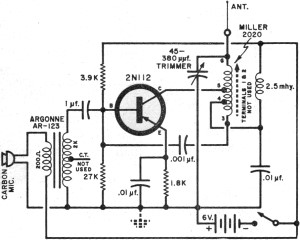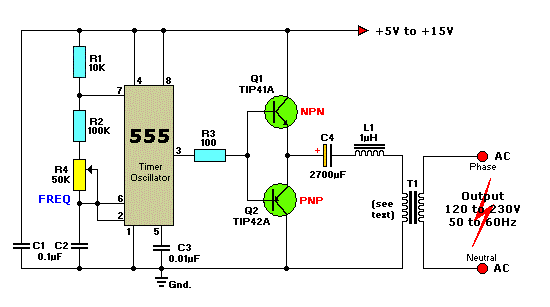
Circuit Diagram 6 zone alarm independent
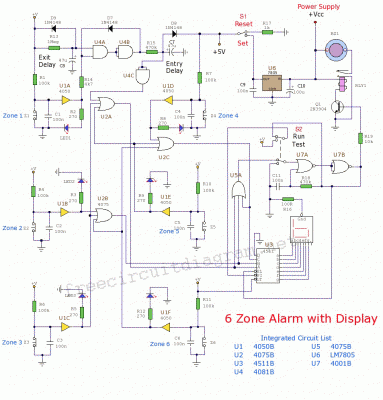
This circuit is a 6-zone alarm system designed for independent operation, suitable for small office or home environments. It can be adapted to utilize a combination lock or keypad for setting and resetting the alarm. All zones, Z1 to Z6, employ normally closed alarm contacts. Zone 1 is designated as a timed zone, serving as the entry and exit point of the building, while Zones 2 to 6 are immediate zones that trigger the alarm without delay. To provide RF immunity for extended wiring runs, input capacitors C1 to C6 are included. The key switch, S1, functions as the Set and Reset/Unset switch; it is recommended to use a metal key switch for enhanced security. Switch S2 typically operates in the run position, but when in the test position, it allows for a walkthrough test of the alarm system. In this test mode, the input of U7A remains low, preventing the alarm from triggering, and the blanking input is high, keeping the 7-segment display illuminated. When all zones are closed, opening any zone will display the corresponding number on the display. It is important to note that if two zones are opened simultaneously, the display may not accurately indicate the correct zone due to the circuit's design. In run mode, the first zone to trigger the alarm is latched and displayed until the alarm is reset.
The 6-zone alarm circuit operates by monitoring six distinct zones for security breaches. Each zone is connected to normally closed contacts, ensuring that any interruption in the circuit will trigger the alarm. Zone 1 serves as a timed entry/exit zone, allowing users a brief period to disarm the system upon entry or exit. The remaining zones (2 to 6) are configured for immediate response, enhancing security by ensuring rapid detection of unauthorized access.
Input capacitors C1 to C6 are strategically placed to mitigate radio frequency interference, which is particularly beneficial for installations with long wiring runs. The use of these capacitors helps maintain signal integrity and reduces false alarms caused by electrical noise.
The key switch S1 is a critical component of the system, providing a physical means to set or reset the alarm. The recommendation for a metal key switch is based on durability and security, which are essential in alarm systems. Switch S2 allows for a testing mode, enabling users to verify the functionality of the alarm system without triggering an actual alarm. In this mode, the system is designed to keep the 7-segment display active, providing a visual indication of any opened zones while preventing alarm activation.
The circuit's design incorporates a unique feature where the first zone to trigger the alarm is latched, ensuring that the user is aware of which zone has been compromised. This feature is particularly useful for troubleshooting and maintenance, as it allows for a clear identification of security breaches. Overall, the 6-zone alarm circuit is a robust solution for enhancing security in small environments, providing flexibility in operation and ease of use.Here is 6 zone alarm independent circuit. this circuit suitable for a small office or home environment, it can also be adapted to use a combination lock or keypad to set and reset the alarm. All zones Z1 to Z6 use normally closed alarm contacts. Zone 1 is a timed zone which must be used as the entry and exit point of the building. Zones 2 to 6 are immediate zones, which will trigger the alarm with no delay. Some RF immunity is provided for long wiring runs by the input capacitors, C1 C6. The key switch, S1 acts as the Set and Reset/Unset switch. For best security this should be the metal type switch with a key. Switch S2 is normally used in the run position. However in the test position, this allows a useful walkthrough test of the alarm. In the test position the input of U7A is always low and will not trigger the alarm, also the blanking input is also high, meaning that the 7 segment display is always illuminated. With all zones closed, open any zone, the corresponding number will be shown on the display. Note that if two zones are opened the diplay will not necessarily indicate the correct zone, this is not a fault, just the way the circuit is designed.
When in run mode, the first zone to trigger the alarm is caught and latched and will be displayed until the alarm is reset. Here is a schematic drawing: We aim to transmit more information by carrying articles. Please send us an E-mail to wanghuali@hqew. net within 15 days if we are involved in the problems of article content, copyright or other problems.
We will delete it soon. 🔗 External reference
The 6-zone alarm circuit operates by monitoring six distinct zones for security breaches. Each zone is connected to normally closed contacts, ensuring that any interruption in the circuit will trigger the alarm. Zone 1 serves as a timed entry/exit zone, allowing users a brief period to disarm the system upon entry or exit. The remaining zones (2 to 6) are configured for immediate response, enhancing security by ensuring rapid detection of unauthorized access.
Input capacitors C1 to C6 are strategically placed to mitigate radio frequency interference, which is particularly beneficial for installations with long wiring runs. The use of these capacitors helps maintain signal integrity and reduces false alarms caused by electrical noise.
The key switch S1 is a critical component of the system, providing a physical means to set or reset the alarm. The recommendation for a metal key switch is based on durability and security, which are essential in alarm systems. Switch S2 allows for a testing mode, enabling users to verify the functionality of the alarm system without triggering an actual alarm. In this mode, the system is designed to keep the 7-segment display active, providing a visual indication of any opened zones while preventing alarm activation.
The circuit's design incorporates a unique feature where the first zone to trigger the alarm is latched, ensuring that the user is aware of which zone has been compromised. This feature is particularly useful for troubleshooting and maintenance, as it allows for a clear identification of security breaches. Overall, the 6-zone alarm circuit is a robust solution for enhancing security in small environments, providing flexibility in operation and ease of use.Here is 6 zone alarm independent circuit. this circuit suitable for a small office or home environment, it can also be adapted to use a combination lock or keypad to set and reset the alarm. All zones Z1 to Z6 use normally closed alarm contacts. Zone 1 is a timed zone which must be used as the entry and exit point of the building. Zones 2 to 6 are immediate zones, which will trigger the alarm with no delay. Some RF immunity is provided for long wiring runs by the input capacitors, C1 C6. The key switch, S1 acts as the Set and Reset/Unset switch. For best security this should be the metal type switch with a key. Switch S2 is normally used in the run position. However in the test position, this allows a useful walkthrough test of the alarm. In the test position the input of U7A is always low and will not trigger the alarm, also the blanking input is also high, meaning that the 7 segment display is always illuminated. With all zones closed, open any zone, the corresponding number will be shown on the display. Note that if two zones are opened the diplay will not necessarily indicate the correct zone, this is not a fault, just the way the circuit is designed.
When in run mode, the first zone to trigger the alarm is caught and latched and will be displayed until the alarm is reset. Here is a schematic drawing: We aim to transmit more information by carrying articles. Please send us an E-mail to wanghuali@hqew. net within 15 days if we are involved in the problems of article content, copyright or other problems.
We will delete it soon. 🔗 External reference
